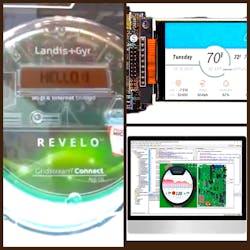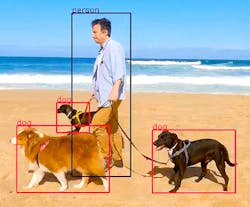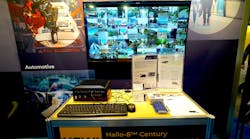In 2022, SecurityInfoWatch and Security Business magazine reported how companies like Lanner and Hailo lowered the AI processing cost of IP video streams to about $50 per stream (minimum of 50 channels, not including management software), creating a market for security integrators to upgrade surveillance systems without installing new cameras.
In 2023, that upgrade path has opened to even smaller systems, and the overall hardware cost is decreased by using lower-cost CPUs paired with more powerful AI processors. Additionally, the processing of different AI algorithms on each stream means users will not have to buy more AI processors to run complex algorithms and manage convolutional neural networks.
This has enabled a familiar trend, which at CES 2023 was recreated as SDx, or “Software Defined Everything.”
CES exhibiting chip makers like Hailo can leverage SDx adoption to begin to replace new cameras in multiple categories, for customers that simply want a system that sees and reacts with full, human-like sensors. The question is, as global chip demand increases, will chip creators or foundries keep up?
MicroEJ: Bringing SDx to the Edge
MicroEJ (pronounced micro-edge), is a maker of software for embedded and IoT devices. The company name is pronounced that way for a reason – because the costs of potential game-changing features, such as an HVAC control, occupancy sensing or security fusion-powered devices, are greatly reduced at the edge.
“In the smartphone industry, we are familiar with apps adding value to the device, extending the usable lifespan and delivering a faster time to market of features. By applying that to any device, any ODM (Original Device Manufacturer) of products like media control, thermostats, security, or cars, can accelerate software innovation,” explained Dr. Fred Rivard, CEO and founder of MicroEJ. “The trend is to become low power, sustainable and have a lower cost to manufacture.”
Rivard explained that SDx means having an API across a range of devices, known as containers. “Even if you change the sensors, the container stays, upgraded, lower power, more powerful, making more efficient use of available bandwidth.”With SDx, a sensor fusion or IP camera manufacturer could perform a virtual version of a client’s requested algorithm – such as sending an alert only, for example, if a thermal imager detects a living person or animal, or if a speeding vehicle is detected and confirmed by a LiDAR sensor.
Landis+Gyr’s “Smart Meters,” which use the MicroEJ SDx platform for energy management, were demonstrated at CES. They illustrate how important it is to see exactly what the end-user’s devices are displaying and how they are behaving. AI Algorithms produce the device’s cybersecurity status, a real-time virtual display of the smart meter, the program code, and any connected devices appear in the “info cockpit.” An engineer can modify a small amount of code, then use the virtual version of the Smart Meter to test the changes before updating the actual device via secure cloud. www.microej.com
Hailo and Lanner: Edge AI’s Impact on Video Surveillance
Based on the innovations at CES, the next two years should see AI algorithms processed on IP video streams at a lower cost. Applying funds to a powerful imaging chipset or AI processor, and then pairing it with a lower-cost CPU will keep overall performance and capability high.
For example, the Hailo-8 AI processor can be paired with cost-effective CPUs like Intel’s Celeron to bring advanced algorithms like human or vehicle group behavior, and skeletal pose detection to smaller surveillance systems.
At Hailo’s CES exhibit, I held in the palm of my hand the new Lanner Falcon PCIe Edge card, fully populated with Hailo-8 AIprocessors. The Lanner Falcon offloads CPU loading for low-latency deep learning inference processing for even the most complex of algorithms. The speed of Convolutional Neural Network (CNN) training and inference significantly reduces the cost and power consumption of the computing power platform, while improving the flexibility, reliability, and real-time performance of the whole system.
Using two popular models to measure the performance of complex neural networks, the Lanner Falcon H8 processes 15,000 Frames Per Second (FPS) for MobileNet-v2 and 8,000 FPS for ResNet-50. The card’s approximate stream capacity would be 8,000 FPS/30 FPS/camera, which would approximately equal 270 AI-processed camera streams for video analytics, traffic management, or entry screening access control. Just two years ago, this would have required a few data center-grade servers. https://hailo.ai
Art of Logic: AI on the Edge
Additionally, Hailo demonstrated several Art of Logic (AOL) Edge AI devices. AOL’s powerful yet cost effective Samurai Detection suite is the first Video Management System of its kind to run multiple AI algorithms with different parameters on the same or different streaming channel, allowing for large compute and AI loads, all while using a low power consumption design.
The ruggedized AI edge embedded system works well for vehicle recognition and public space utilization in smart cities, peoplecounting, and safety and operational efficiency on industrial sites. Its amazing Europa Micro Server has a power utilization of under 10W with more computational power than most high-end IP cameras.
“You want to do different jobs with different cameras in different places,” explained Hailo’s Chen Loewy. “The challenge is to provide both security and safety algorithms, running efficiently in real time at low power.” www.artoflogic.ai
Tatille: AI-Powered ANPR
Italian Automatic Number Plate Recognition (ANPR) specialist Tattile now has the “SMART+” in production, the first of a new product line of smart city cameras with the Hailo-8 processor. The power of a multi core CPU, paired with the Hailo AI processor delivers consistent data stream analysis in real time, in challenging conditions like ANPR in bumper-to-bumper traffic, simultaneous, multi-lane, multi-direction freeway vehicle identification, congestion control and automatic fare collection.
Tatille was already the Electronic Toll Collection “standard” in Europe; now reliable traffic flow and vehicle behavior is possible with complex computer vision processes offloaded to the Hailo chipset. www.tattile.com
CISA: DHS Presence Underscores Importance of SDx Security
Software-defined networking (SDN) is part of SDx and centralizes network configuration, management functionality and cybersecurity policies, countermeasures, and device upgrades.
In 2021, Russian hackers breached controls for the largest fuel pipeline in the U.S., causing the Colonial Pipeline Company to shut down its pipeline, for six days to contain the attack. SDN allows more frequent and effective cybersecurity upgrades without the need for a “drive-by,” to locally connect to legacy wireless Electric Meters.
SDx is not a “nice to have” convenience; in fact, at CES, the U.S. Department of Homeland Security’s Cybersecurity & Infrastructure Security Agency (CISA) exhibited in the “Sustainability Zone” to encourage developers to increase trust in software by including “as you program” build requirements the new Software Component Verification Standard (SCVS).
The software build environment is a prime target in the software supply chain. In this scenario, the threat actor infiltrates the development network, performs a scan to locate build systems, identify vulnerabilities, and deploys the exploit. CISA is leveraging shows like CES for outreach to industry, especially important when considering SDx platforms. www.cisa.gov
Steve Surfaro is Chairman of the Public Safety Working Group for the Security Industry Association (SIA) and has more than 30 years of security industry experience. He is a subject matter expert in smart cities and buildings, cybersecurity, forensic video, data science, command center design and first responder technologies. Follow him on Twitter, @stevesurf.









